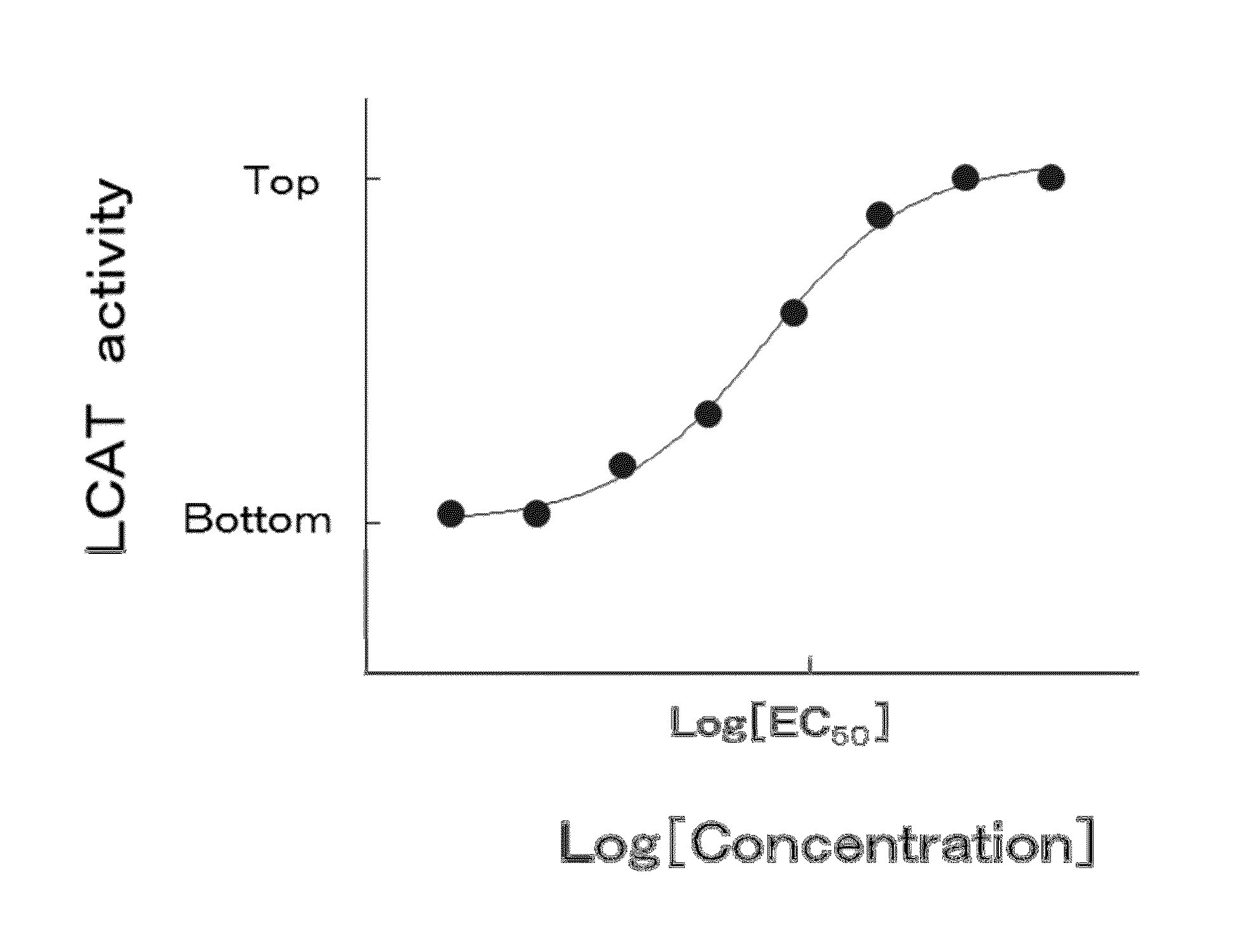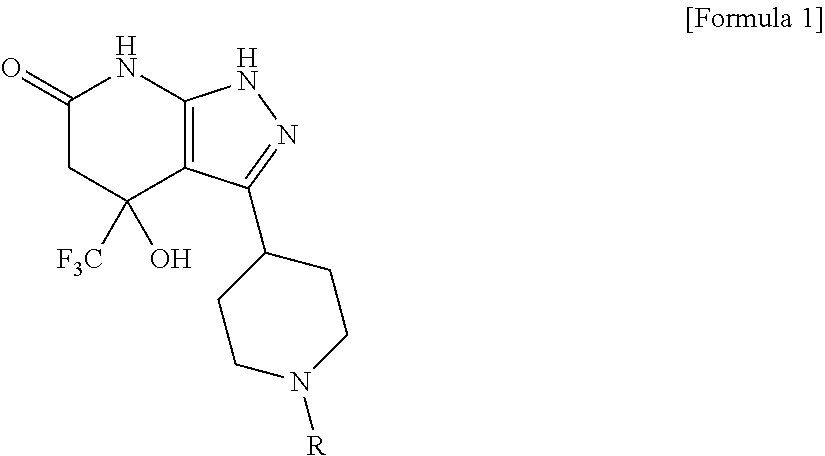Piperidinylpyrazolopyridine derivative
a technology of pyrazolopyridine and piperidinylpyrazolopyridine, which is applied in the direction of drug composition, dispersed delivery, metabolic disorder, etc., can solve the problems that the use of these medicaments has not produced a great improvement in the death rate attributed to cardiac disease, cerebrovascular disease, renal disease, etc., and achieves excellent lcat-activating
- Summary
- Abstract
- Description
- Claims
- Application Information
AI Technical Summary
Benefits of technology
Problems solved by technology
Method used
Image
Examples
reference example 1
3-Oxo-3-[1-(pyridin-2-yl)piperidin-4-yl]propanenitrile
[0199]
[0200]Five drops of DMF were added to a solution of 1-(pyridin-2-yl)piperidine-4-carboxylic acid (1.10 g, 5.33 mmol) in dichloromethane (20 mL), then oxalyl chloride (0.60 mL, 6.88 mmol) was added thereto at 0° C., and the mixture was stirred for 25 minutes. Then, the solvent in the reaction solution was distilled off under reduced pressure to obtain an acid chloride compound.
[0201]n-Butyllithium (2.69 M solution in hexane, 7.50 mL, 20.18 mmol) was added dropwise at −78° C. to a solution of cyanoacetic acid (800 mg, 9.41 mmol) and 2,2′-bipyridyl (5 mg, 0.03 mmol) in anhydrous THF (50 mL), and then, the mixture was stirred at the same temperature as above for 30 minutes. To the resulting reaction solution, a solution of the above-obtained acid chloride compound in anhydrous THF (10 mL) was added dropwise at −78° C., and the mixture was stirred at the same temperature as above for 1 hour. A saturated ammonium chloride aqueous...
reference example 2
3-[1-(Pyridin-2-yl)piperidin-4-yl]-1H-pyrazol-5-amine
[0203]
[0204]Hydrazine monohydrate (0.20 mL, 4.12 mmol) was added to a solution of 3-oxo-3-[1-(pyridin-2-yl)piperidin-4-yl]propanenitrile (138 mg, 0.60 mmol) produced in Reference Example 1 in ethanol (20 mL), and the mixture was stirred for 5 hours under heating to reflux. The reaction solution was left until reaching room temperature, and then, the solvent was distilled off under reduced pressure. The obtained residue was purified by silica gel column chromatography [elute: ethyl acetate / methanol=100 / 0-94 / 6 (gradient)] to obtain the title compound (130 mg, yield: 89%).
[0205]1H-NMR (500 MHz, DMSO-d6) δ: 11.18 (1H, brs), 8.09 (1H, d, J=4 Hz), 7.50 (1H, t, J=8 Hz), 6.83 (1H, d, J=9 Hz), 6.59 (1H, t, J=6 Hz), 5.18 (1H, s), 4.45 (2H, brs), 4.31 (2H, d, J=13 Hz), 2.85 (2H, t, J=13 Hz), 2.70 (1H, t, J=12 Hz), 1.87 (2H, d, J=13 Hz), 1.55-1.44 (2H, m).
reference example 3
3-(1-Phenylpiperidin-4-yl)-1H-pyrazol-5-amine
[0206]
[0207](1) 3-Oxo-3-(1-phenylpiperidin-4-yl)propanenitrile was obtained through the same reaction as in Reference Example 1 using 1-phenylpiperidine-4-carboxylic acid (1.01 g, 4.92 mmol) instead of 1-(pyridin-2-yl)piperidine-4-carboxylic acid.
[0208](2) The title compound (648 mg, yield: 54%) was obtained through the same reaction as in Reference Example 2 using the compound obtained in (1) instead of 3-oxo-3-[1-(pyridin-2-yl)piperidin-4-yl]propanenitrile.
[0209]1H-NMR (500 MHz, DMSO-d6) δ: 11.19 (1H, brs), 7.23 (2H, t, J=8 Hz), 6.98 (2H, d, J=8 Hz), 6.78 (1H, t, J=7 Hz), 5.25 (1H, brs), 4.40 (1H, brs), 4.15 (1H, brs), 3.73 (2H, d, J=13 Hz), 2.75 (2H, td, J=12 Hz, 2 Hz), 2.68-2.58 (1H, m), 1.98-1.91 (2H, m), 1.67 (2H, dq, J=12 Hz, 4 Hz).
PUM
 Login to View More
Login to View More Abstract
Description
Claims
Application Information
 Login to View More
Login to View More - R&D
- Intellectual Property
- Life Sciences
- Materials
- Tech Scout
- Unparalleled Data Quality
- Higher Quality Content
- 60% Fewer Hallucinations
Browse by: Latest US Patents, China's latest patents, Technical Efficacy Thesaurus, Application Domain, Technology Topic, Popular Technical Reports.
© 2025 PatSnap. All rights reserved.Legal|Privacy policy|Modern Slavery Act Transparency Statement|Sitemap|About US| Contact US: help@patsnap.com



